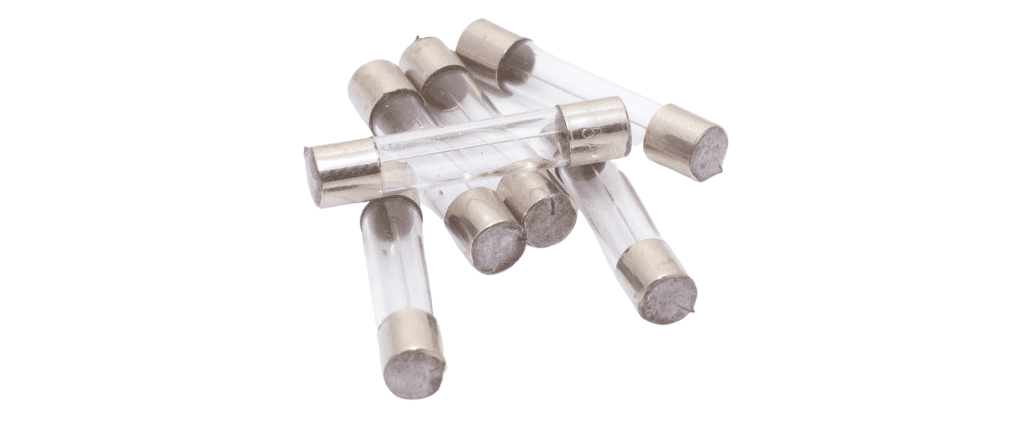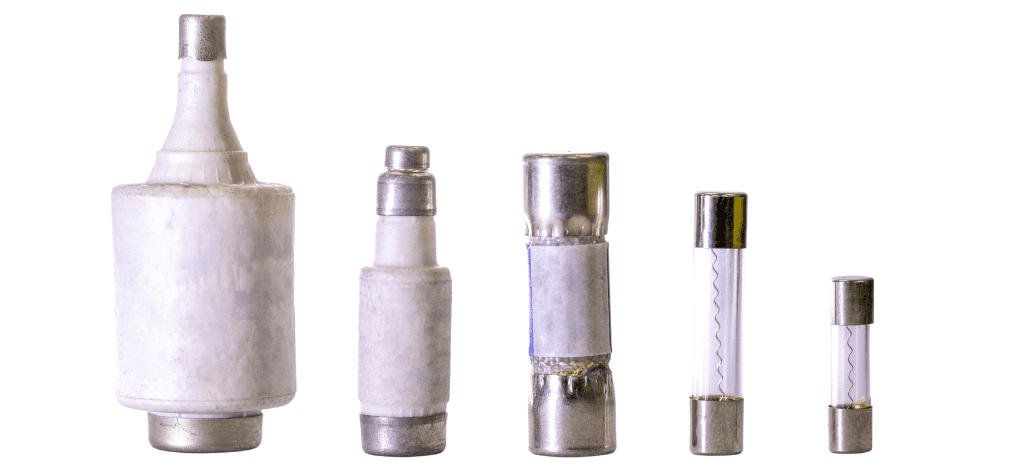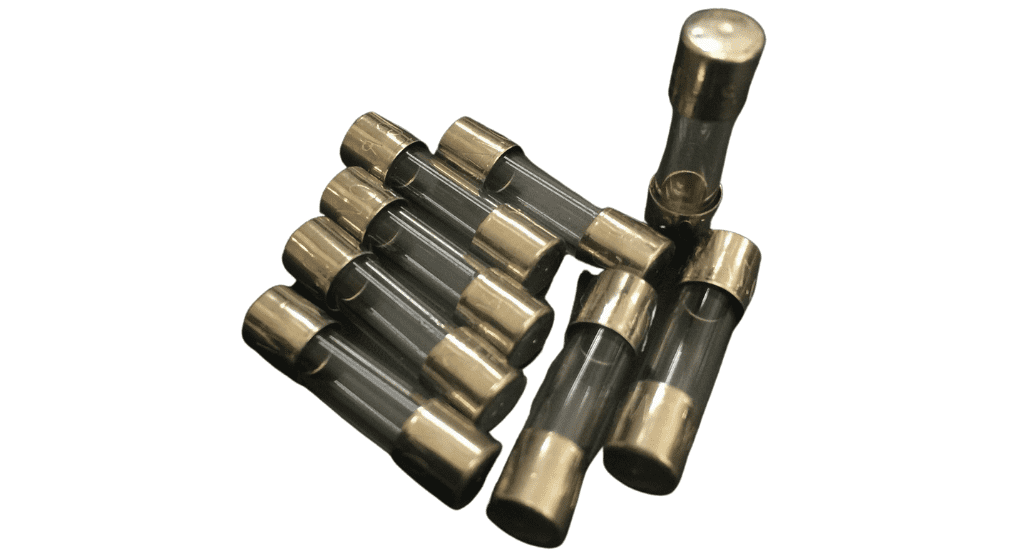What Is An Electric Fuse And How Does It Work?
A lot of electric components in your home owe their safety to the fuse.
Whenever you experience immense power surges but still find that your extension socket hasn’t been burnt to dust, the fuse, when used, is a component that ensures this is the case.
What is a fuse, and how does it work?
Our guide seeks to answer these questions today as we present all you need to know about one, including the different types and how a fuse differs from a circuit breaker.
Let’s get right into it.
What is a Fuse?
An electrical fuse is a small device with a thin strip of conductor that protects homes and appliances against excessive power surges. It is an electrical safety device that cuts power off to the appliance or electrical system when the flowing current surpasses its recommended rating.

Electricity isn’t just an element that poses a shock hazard to us. Just as humans have a maximum amount of voltage that can flow through the body without causing any fatalities, your electrical appliances and systems typically have their own current and voltage ratings.
When the supply of electricity surpasses these ratings, your electrical systems are dealt a fatal blow. In homes and businesses, this means spending a lot of money to repair or even replace expensive devices and appliances.
Sometimes, a surge like this, when there is no protection, may even cause fire hazards and prove very dangerous to humans. To protect against the adverse effects of overcurrent, the fuse comes into play.
What Does a Fuse Do?
To protect against power surges, the thin conducting strip in the fuse melts and breaks the circuit. This way, the flow of electricity to other components within the circuit is interrupted and these components are saved from burning. The fuse is used as a sacrifice to protect against overcurrent.

The thin conductor is an internal wire or element made from zinc, copper, or aluminum, among other metals whose characteristics may be predicted.
The fuse is fitted in series within the circuit so that all current flows through it. In the fuse itself, the wires are installed between the two terminals and contact the terminals at both ends.
Apart from blowing due to excess electricity supply, fuses also break when there is a short or ground fault.
A ground fault occurs when there is an alien conductor that serves as an alternate ground in the circuit.
This short could be from a human hand or any metal object coming in contact with a live wire. An electrical fuse designed for this also blows or melts.
Knowing whether a fuse has blown is a relatively easy task. You can perform visual inspections on transparent types by checking whether the wire has snapped or melted, or whether there are signs of burn.
You may also use a multimeter to test a fuse for continuity. This is the most accurate diagnosis method.
Electrical Fuse Characteristics
Fuses come in different designs and with different ratings. A fuse rating is the maximum amount of current or voltage that can pass through its thin metal wire before it melts down.
This rating is usually 10% lower than the rating of the device the fuse safeguards so that the protection is adequate.
The fuse may also come with different breaking capacities and have different response times, based on the type of fuse it is.

Current Rating
The current rating is the maximum amperage the fuse is designed to allow to pass through. Any slight excess in this rating makes the wire burn down.
However, this rating is always used alongside a volt rating and response time rating, which all depend on the circuit the fuse is used in.
Voltage Rating
Just like the current rating, the volt rating of a fuse is the maximum volt the metal strip may accommodate. When determining this rating, however, it is usually placed higher than the volt supply from the source.
This is especially when multiple devices using the same current rating but different volt ratings are present within an electrical system. The volt rating is usually set to the highest safe voltage.
Due to this, medium-volt varieties are not used within low-volt circuits or systems to maintain close protection of the components.
Response Time
The response time of a fuse is the delay before the metal strip burns down. This response time works closely with the current rating to be as adequately protective as possible.
For instance, standard fuses require a current supply twice their rating to blow in one second, while fast-blow ones with this same rating and supply may burn our in 0.1 seconds. A slow-blow fuse cuts off the power supply after over 10 seconds.
Making a choice from these depends on the sensitivity and characteristics of the device to be protected.
Fast-responding fuses are used in devices with components that are very susceptible to the slightest current spikes, while the slow-responding or time-delay varieties are used in motors where it is common for components to draw higher current than usual for several seconds.
Breaking Capacity
The breaking capacity of a fuse is a rating used in high rupture capacity (HRC) versions. HRC fuses allow overcurrent to pass through for some time with the expectation that it reduces. They then break or melt if this reduction doesn’t happen.
You may have guessed right that this is common with time-delay types and the breaking point is simply the maximum current supply allowed during this short delay time.
When the time delay rating isn’t reached but the breaking point is surpassed, the fuse blows off or melts down. This is a form of double protection. HRC fuses may also be called High Breaking Capacity (HBC) fuses in this regard.
There are also high-voltage HRC fuses used in high-volt electrical circuits and low-voltage HRC fuses used in low-volt distribution systems. These low-voltage HRC fuses are typically bigger than regular fuses.
Fuse Construct
Overall, the ratings of a fuse determine its strength and construction. For instance, in large-capacity fuses, you may find multiple strips or metal wires, while some other fuses utilize steel bars to support the strip against strain.
Some use materials to control the splitting of metal and you will also find strip wires that are made like springs to speed up the parting process.
History of The Fuse
The history of the fuse may be traced as far back as 1864. This is when Breguet suggested a conducting device be used at a section to safeguard telegraph stations against lightning strikes. A lot of conductive wires that worked just like a fuse were then created to serve this purpose.
It wasn’t until 1890, however, that Thomas Edison patented the use of the fuse within electricity distribution systems to safeguard homes from these immense current spikes.

What Are the Different Types of Fuses?
Generally, there are two categories of fuses. These are AC fuses and DC fuses. Understanding the difference between these two isn’t difficult.
AC fuses simply work with alternating current while DC fuses work with direct current. One significant difference between these two, however, is that you may find DC fuses to be slightly bigger than AC fuses.
Now, these two fuse categories are divided into Low-volt fuses and High-volt fuses. The more specific variations of fuses are then distributed under these two groups.
Low Voltage Fuses
Low-voltage fuses are fuse elements that work with low-voltage ratings. They may be split into five types; cartridge fuses, rewirable fuses, striker fuses, switch fuses, and drop-out fuses.
- Rewirable Electric Fuses: Rewireable fuses are the common ones you find in electricity distribution systems in homes and offices. They are usually porcelain-covered fuses with a handle that work with a fuse base. They also have two blade terminals for receiving and sending out electricity within the circuit, just like the usual construction of fuses.
Rewireable fuses are used in home and office settings because of the ease at which they may be plugged into and removed from the base.
- Cartridge Electric Fuses: These are fuses with all components entirely fit into a container, with only the terminals to plug into the circuit exposed. Cartridge fuses come in different forms and have different uses.
The D-Type cartridge electrical fuses are bottle-shaped and the most common you find in small appliances. They are usually fitted into a ceramic body with metal ends to conduct electricity.
Link fuses are low-voltage HRC fuses, while blade fuses can be easily changed like rewireable fuses but are covered in plastic instead. Blade fuses are commonly used in cars.
- Striker Electric Fuses: A striker fuse does not utilize a thin melting strip. Instead, it shoots out the contacting pin to break the circuit and also serve as an external visual cue to identify that the fuse is blown.
- Switch Electric Fuses: These are fuses used in low-voltage systems with external switches that you can use to close or open the current pathway.
- Drop-Out Fuses: Drop-Out fuses expel the melted strip from beneath and are usually found in hanging low-voltage transformer systems.
High-Voltage Fuses
High-voltage fuses come in multiple variations. There are liquid HRC high-voltage fuses that employ liquids to extinguish the arcing process.
We also have expulsion fuses using boric acid for the interruption process and cartridge-type HRC fuses that work just like the low-voltage counterpart.
Where Should Fuses Be Used?
Fuses are commonly used with small and large AC-powered systems with transformers. High-voltage fuses having high current ratings are used in power system transformers working with up to 115,000 volts.
Low and medium-voltage fuses are used to safeguard small electrical transformer systems. These include systems in televisions, refrigerators, and computers, among others.
Additionally, regardless of whether a fuse can be installed anywhere within a circuit, the best place to install one is at the beginning of the system. This is why you see fuses installed at the plugs of home appliances or the front of a transformer’s primary point of connection.
What Are Fuse Boxes?
Fuse boxes are hubs in electrical systems that house multiple fuses protecting different parts of your home or office. They serve as a form of default protection against power surges, in case one of your appliances does not come with an internal fuse.
You will commonly see fuse boxes referred to as breaker panels or junction boxes, but all these perform the same function. They accommodate between six to 12 individual fuses with individual ratings.
Although older residential fuse boxes were configured to accommodate a total of only 60-amps, today we see fuse boxes with 200-amp total ratings. This is the sum of all individual fuse ratings in the box.
Now, it is common to mistake fuse boxes for circuit breaker boxes.
Difference Between Fuses With Circuit Breakers
Circuit breakers perform the same function as electrical fuses; they safeguard home appliances from electrical surges by cutting off the circuit pathway. How the two devices do this, however, differs.
Rather than having a melting or expunged strip, circuit breakers work with internal contacts and external switches. The internal contacts ordinarily complete the circuit but move when there is an overcurrent supply. The external switch control helps to reset the contacts and circuit breaker into the protective state.
From this, you see that, while fuses are always replaced when they blow out, circuit breakers are reusable over and over again. You just have to reset them. Circuit breaker boxes then include a barrage of these switches, rather than fuses.
When To Replace A Fuse
A fuse can last a lifetime as long as it is installed within recommended power systems and there are no power surges. This is the same when it isn’t installed in a wet or humid environment where it is prone to corrosion.
Nonetheless, you should always move to change fuses after 20 to 30 years of use. This is their usual lifespan.
Video Guide
Conclusion
Using appliances without an electrical fuse or having a home without an electrical fuse box is a precursor for electrical and fire disasters. Always ensure you have the right fuse installed into electrical systems or circuits and be sure to replace one if it has blown out.
FAQs
What Is a Fuse Used For?
A fuse is used to protect circuits from power surges or short grounding faults. It has an internal metal strip that snaps or burns to cut off the current pathway and interrupt the electricity supply.
Does a Fuse Reduce Current?
Only current-limiting fuses reduce the current supply when the circuit has experienced a surge. Others don’t reduce current in circuits but rather completely prevent it from flowing.

Author
Alex Klein is an electrical engineer with more than 15 years of expertise. He is the host of the Electro University YouTube channel, which has thousands of subscribers.
